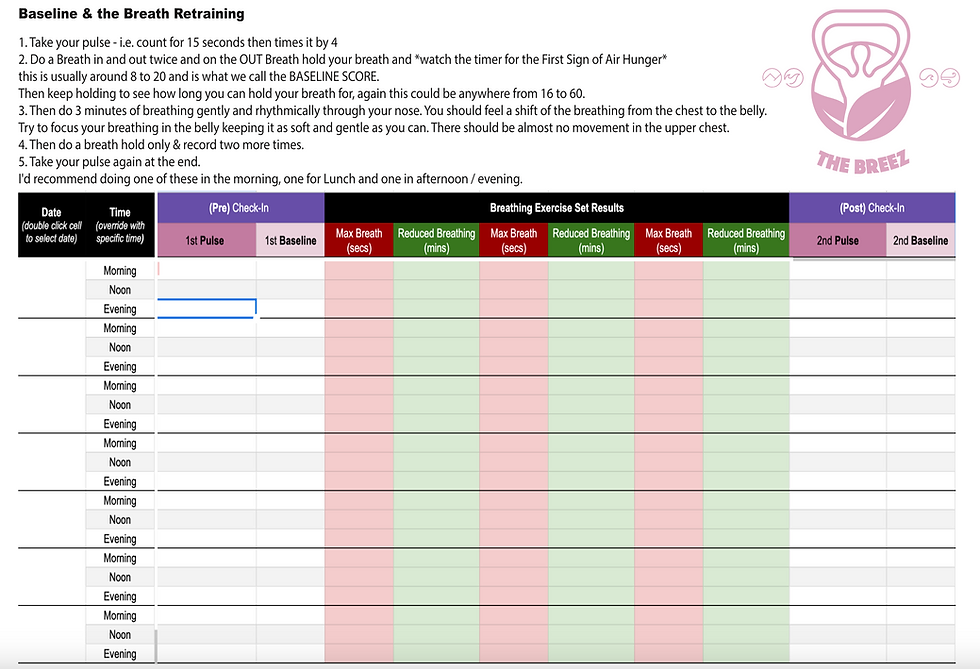Breathing Retraining
- barefit
- Oct 7, 2024
- 3 min read
Updated: Nov 5, 2024

Developed in 1952 by Ukrainian Dr Konstantin Pavlovich Buteyko, the Buteyko Method is a breathing technique designed to improve functional breathing patterns, health and wellbeing by altering the way you breathe.
By practicing breathing exercises from the Buteyko Method you can experience more open airways and improved blood circulation in a matter of minutes. This alone is enough to demonstrate the relationship between your everyday breathing and state of health.
Nose Unblocking Exercise

The nose unblocking exercise is a simple exercise designed to unblock the nose and make functional nasal breathing easier. It involves taking a normal breath in and out through your nose, pinching the nose to stop air entering, nod the head until there is a moderate air hunger, then stop pinching the nose and breathe in through it.
Baseline & the Breath Retraining
The intention of the exercise is to reduce the volume of air you are taking into your lungs, in order to create a tolerable air hunger, in other words to breathe less air. By breathing less air, carbon dioxide slightly accumulates in the blood.Practicing breathing light, helps to ensure slower, lighter and lower breathing patterns. Benefits include:
Dampening of the stress response
Activation of the relaxation response
More open airways including the nose and lungs
Improved quality of sleep
1. Take your pulse - i.e. count for 15 seconds then times it by 4. Do a Breath in and out twice and on the OUT Breath hold your breath and watch the timer for the First Sign of Air Hunger- this is usually around 8 to 20 and is what we call the BASELINE SCORE. Then keep holding to see how long you can hold your breath for, again this could be anywhere from 16 to 60.3. Then do 3 minutes of breathing gently and rhythmically through your nose. You should feel a shift of the breathing from the chest to the belly. Try to focus your breathing in the belly keeping it as soft and gentle as you can. There should be almost no movement in the upper chest.4. Then do a breath hold only & record two more times5. Take your pulse again at the end
I'd recommend doing it in the morning, one for lunch and one in afternoon / evening.

If you feel a sensation of air hunger during normal everyday breathing, are sighing frequently, experiencing disproportionate breathlessness during physical exercise or have a faster breathing pattern, strong chemosensitivity to CO2 is feeding into these symptoms.
Chronic stress, trauma and anxiety, increase the chemosensitivity to CO2. Everyday breathing then becomes faster and harder and this can affect us to differing degrees.
Walking with Mouth Closed

An excellent breathing exercise is to walk with your mouth closed. As you exercise, oxygen uptake in the blood is higher, oxygen delivery to the working muscles is increased, the airways are protected and there is better recruitment of the diaphragm.
Breathing through the nose adds an extra load onto breathing and this may help to improve respiratory muscle strength.
With normal breathing in and out through the nose, pinch the nose and hold. Walk for 10 paces, then inhale through nose. Resume normal breathing while still walking for 30-60 paces. Let go, breathe normally for 30 seconds and repeat.
Continue exhaling through the nose, pinching the nose and holding your breath. First at 10 paces and repeat, then at 15 and repeat. Continue raising by 5 paces after each two rounds until a medium to strong air hunger is achieved.
Light air hunger for Severe Asthma, Anxiety, Panic Attacks
The steps exercise is one of the best for creating air hunger, improving CO2 sensitivity and improving breathing efficiency. Take a normal breath in through the nose, out through the nose, pinch your nose and hold your breath for 5 to 10 paces. Rest for 30 seconds and repeat. This should create a moderate air hunger and is a great help for sufferers of severe asthma, COPD, panic disorder, anxiety and breathlessness.
it’s usually a good rule of thumb to practice your recommended Buteyko breathing techniques for 20-60 minutes daily.
It is far better to breathe through the nose. Breathing through the nose increases oxygen uptake in the blood, protects the airways and helps us relax. By nasal breathing
we take advantage of natural defenses like nasal mucosa and the small cilia hairs of the nose that prevent pathogens from reaching our lungs and making us potentially ill. Also, the presence of nasal nitric oxide, a natural anti-viral, increases in the nose when we breathe nasally.
Mouth breathing typically activates the stress response, reduces oxygen uptake and can irritate the airways as cold dry air is taken directly into the lungs. It is especially pertinent for persons prone to breathing disorders including asthma to breathe only through the nose during rest, physical exercise and sleep.
コメント